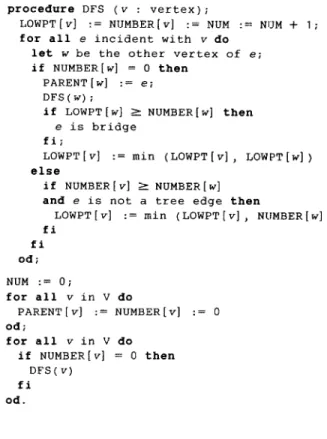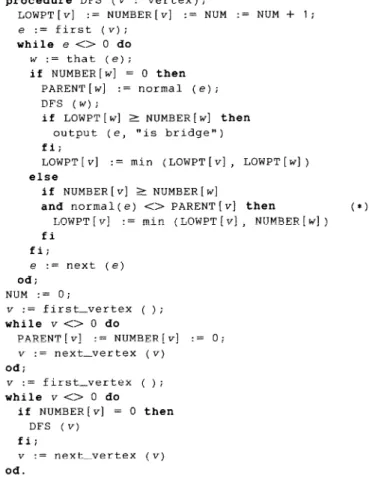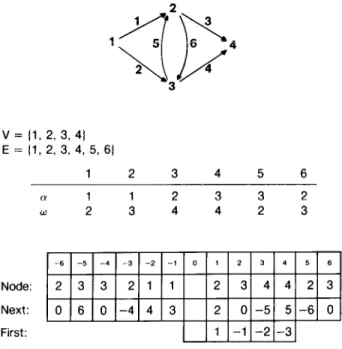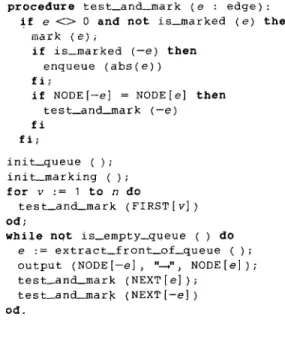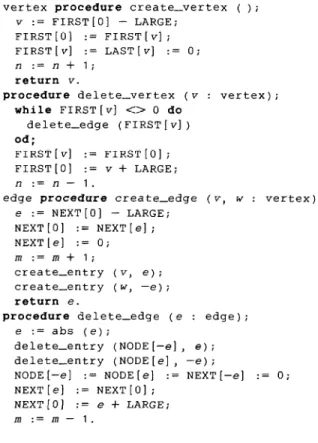Edgar H. Sibley
Panel Editor
An abstract graph module that allows
foreasy and secure programming
ofa great number
ofgraph algorithms is implemented by symmetrically stored forward and backward adjacency lists, thus supporting edge-oriented
traversals
ofgeneral directed and undirected graphs.
A VERSATILE DATA STRUCTURE FOR EDGE-ORIENTED GRAPH Al.GORlTHMS
JiiRGEN EBERT
It is widely accepted that graphs are a useful medium for modeling relevant parts of reality in computer programs. Graphs are rather natural models for road maps, electrical networks, chemical structure formulas, data and control flow of com- puter programs, state spaces of discrete games, socio- logical diagrams, timetables, etc. In addition, many discrete problems in several areas (e.g., formal lan- guage theory, automata theory, compiler construc- tion, operating-systems theory, operations research) can be transformed into equivalent graph problems and then solved using graph algorithms.
Representation greatly influences the efficiency of graph algorithms. Often, linearity can only be achieved through appropriate storage of adjacency information (see, e.g., [6]). There are several differ- ent ways of internally representing graphs in pro- cedural languages, including adjacency matrices, sequential or linked adjacency lists, and edge lists (cf. [Z]). On the other hand, good and clear algorithm design is greatly enhanced by rather abstract graph representations that include operations on the graph, as well as control statements (e.g., for-loops) trig- gered by the graph.
01987 ACMOOOI-0782/87/0600-0513 750 Using a very general type of graph definition, a
In this article we describe an abstract module for graph handling that is especially suited for the edge- oriented paradigm of programming graph algorithms, and show how this module can be implemented effi- ciently in Algol-like languages. This graph realiza- tion is of the adjacency-list type and is suitable for directed and undirected graphs (with multiple edges allowed). Undirected graphs are represented as di- rected graphs through arbitrary assignment of direc- tions to every edge (and not through storage of the corresponding symmetric graph). This representation has been used successfully in a number of applica- tions; for instance, it has been used as a tool for representing the graphs in the EMS project on the implementation of functional languages [3].
GRAPHS
There is a large variety of graph types. Depending on the area of application, graphs can be directed or undirected, weighted or unweighted, and ordered or unordered. Multiple edges and loops are either permitted or forbidden. Here, we present a graph representation that is suitable to all of these variants ([l] and [5] are introductory books on graph theory;
[Z] and [4] introduce graph algorithms).
Iune 1987 Volume 30 Number 6 Communications of the ACM 513
(finite) directed graph G = (V, E, (Y, w) consists of a finite nonempty set V of vertices, a finite set E of edges (with V O E = 0), and two functions (Y: E -P V (denoting the start vertex) and w: E + V (denoting the end vertex of each edge). If there is an edge e with vertices v = u(e) and w = w(e), then w is a successor of v and v is a predecessor of w. Those edges e with v = a(e) (“e goes out of v”) constitute the fomard star of v. Analogously, the backward star of v consists of those edges e with v = o(e) (“e goes into v”).
On the other hand, a (finite) undirected graph G = (V, E, ‘P) contains only one function
P:E+=(WCVll I JWl ~Z],assigninguptotwo vertices to every edge. A self-loop is an edge e with 1 ‘P(e) 1 = 1. If v E P(e), we say v and e are incident.
The star of a vertex v consists of those edges that are incident with v. The degree y(v) of v is the number of edges incident with v, where self-loops are counted twice.
For a directed graph G = (V, E, LY, o), the under- lying undirected graph H = (V, E, P) is given by
‘P(e) = (o!(e), o(e)). Thus, all concepts and algorithms defined for undirected graphs can also be used for directed graphs through simple reference to their underlying undirected graphs. Thus, an edge e and a vertex v are incident if v = cu(e) or v = .o(e), and e is a self-loop if a(e) = w(e).
With the implementation given below, the repre- sentation of the underlying undirected graph is iden- tical to the representation of the graph itself. Thus, algorithms that were designed for undirected graphs (e.g., algorithms for finding spanning trees, testing (bi-)connectivity) can be executed on directed graphs without further adaptation.
EDGE-ORIENTED GRAPH ALGORITHMS
The graph module described here strongly supports an edge-oriented way of handling graphs. This para- digm makes programming more secure and is at the same time suitable for handling graphs with multi- ple edges.
The following conventions apply to edge-oriented programming of graph algorithms:
(1)
(4
Neighborhoods of vertices are traversed by ref- erence to the edges incident with a given vertex.
Edges are regarded as objects having two states.
They may be pointing outwards (positive sign) or pointing inwards (negative sign).
Thus, for processing the successors of a given vertex v, one must proceed as follows:
foralledges eoutof vdo
letwbetheother vertexof e;
process w od.
514 Communications of the ACM
procedure DFS (v : vertex);
LOWPT[v] := NUMBER(v] := NUM := NiJM + 1;
for all e incident with v do let w be the other vertex of e;
if NUMBER[w] = 0 then PARENT[w] := e;
DFS(w);
if LOWPT[w] 1 NUMBER [w] then e is bridge
fi;
LOWPT[v] := min (LOWPT[v], LOWPT[w]) else
if NUMBER[v] L NUMBER[w]
and e is not a tree edge then
LOWPT[v] := rain (LOWPT[v], NUMBER[w] ) fi
fi od;
NUM := 0;
for all Y in V do
PARENT[v] := NUMBER[v] := 0 od;
for all v in V do if NUMBER] v] = 0 then
DFS ( v) fi od.
FIGURE 1. An Edge-Oriented Pseudocode Version of a Bridge Detection Algorithm
edge procedure first-out (v : vertex) returns first edge going out of 11.
edge procedure next-out (e : edge) returns edge following e in forward star of alpha(e).
edge procedure first-in (v : vertex) returns first edge going into v.
edge procedure next-in (e : edge) returns edge following e in backward star of omega(e).
edge procedure first (v : vertex) returns first edge incident with v.
edge procedure next (e : edge) returns edge following e in star of this(e).
vertex procedure first-vertex ( ) returns first vertex of the graph.
vertex procedure next-vertex (v : vertex) returns vertex following Y in the graph.
edge procedure first-edge ( ) returns first edge of the graph.
edge procedure next-edge (e : edge) returns edge following e in the graph.
These procedures return a n i 1 value if there is no object to be returned.
FIGURE 2. Traversal Procedures for the Translation of the Pseudocode f or-Statements
fune 1987 Volume 30 Number 6
The sign of the edges makes it possible to talk about the “other” vertex.
Using loops over edges and giving a state to the edges allow a straightforward translation for for- loops into a combination of a whi le-loop and some standard function calls, since signed edges contain enough information to (re)enter a while-loop to process the next edge. This is not possible for loops over (e.g., successor) vertices. Furthermore, travers- ing neighborhoods by explicitly looking at all inci- dent edges clarifies the fact that successors are listed more than once, if multiple edges exist. (A vertex- oriented for-loop is often valid only for graphs without multiple edges.)
In addition, the sign on the edges allows sufficient information to be kept for deferred processing, if-as in some search algorithms-edges are stored for later use in an intermediate data structure. When an edge is retrieved, its sign helps to deduce its provenance.
Assigning directions (signs) to edges also helps to distinguish incoming from outgoing edges during un- directed searches in directed graphs. Furthermore it helps to describe the direction of edges in (undi- rected) cycles and/or cuts of directed graphs.
As an example, Figure 1 shows an edge-oriented pseudocode version of a bridge detection algorithm (derivable from [6]). Note that this algorithm works on undirected graphs, though the input graph might be directed. Here, the PARENT-entries, which de- note a spanning tree in a multigraph, contain edges (instead of vertices), since there is at most one in- coming tree edge for every vertex.
GRAPH OPERATIONS
We now give the description of a module (in the sense of an abstract data structure) for implementing edge-oriented algorithms in Algol-like languages.
if LOWPT[w] 2 NUMBER[w] then output (e, "is bridge") fi;
LOWPT[v] := min (LOWPT[v], LOWPT[w]) else
For programming a pseudostatement like the for- loop over the outward star from above, we use tra- versal functions first-out and next-out and an auxiliary function omega according to the following:
if NUMBER[v] 1 NUMBER[w]
and normal(e) <> PARENT[v] then (*) LOWPT[v] := min (LOWPT[v], NUMBER[w]) fi
fi;
e := next (e) od;
e :=first-out (v);
while e<>O do w:=omega (e);
process w;
e:=next-out(e) od.
NUM := 0;
v := first-vertex ( );
while II <> 0 do
PARENT[v] := NUMBER[v] := 0;
v := next-vertex (v) od;
Note that this is a very straightforward way of trans- lating for-loops, which is made possible by the “di- rection” (sign) assigned to every edge value. Since the edges denoted by e point outward, it is possible to identify the “next” edge as the next one going out of the same start vertex.
v := first-vertex ( );
while v <> 0 do if NUMBER(v] = 0 then
DFS (v) fi;
II := next-vertex (v) od.
Figure 2 lists the traversal functions necessary for FIGURE 4. A Concrete Program for Bridge Detection, Showing the translation of the pseudocode for-statements. How the Procedures from Figures 2 and 3 Can Be Used
Note that these functions assume an arbitrary but fixed order on all sets. For handling “signed” edges, some auxiliary transfer functions like those listed in Figure 3 are necessary. Figure 4 shows how the bridge detection algorithm of Figure 1 can be pro-
vertex procedure alpha (e : edge) returns start vertex of e.
vertex procedure omega (e : edge) returns end vertex of e.
vertex procedure this (e : edge)
returns start vertex of e, if e is positive, and end vertex, otherwise.
vertex procedure that (e : edge)
returns end vertex of e, if e is positive, and start vertex, otherwise.
edge procedure normal (e : edge) returns edge e with positive direction.
edge procedure reverse (e : edge) returns edge e with reversed direction.
FIGURE 3. Auxiliary Transfer Procedures for Handling “Signed” Edges
procedure DFS (v : vertex);
LOWPT[v] := NUMBER[v] := NUM := NUM + 1;
e := first (v);
while e <> 0 do w := that (e);
if NUMBER[w] = 0 then PARENT[w] := normal (e);
DFS (w);
June 1987 Volume 30 Number 6 Communications of the ACM 515
v = 11, 2, 3, 4) E = (1, 2, 3, 4, 5, 61
1 2 3 4 5 6
a 1 1 2 3 3 2
w 2 3 4 4 2 3
Node:
Next:
First:
FIGURE 5. A Sample Graph and Its Array Representation
grammed using these procedures. Note that this pro- gram, though designed for undirected graphs, also handles directed graphs without any further action or adaptation.
Since edges are signed objects, some care has to be taken in testing edge equality. In the line marked with a star (*) in Figure 4, both sides of the inequal- ity sign were simply normalized.
The next section shows that all operations used thus far can be implemented efficiently. A great number of graph algorithms can be formulated using only the operations described here. In [Z], for instance, it is shown that all the generally used effi- cient graph algorithms can be based on the opera- tions described here (except for the class of all-pair- shortest-path algorithms, which usually use some kind of is-edge ( v, w)-test).
GRAPH REPRESENTATION
Adjacency lists are usually used to store the succes- sors of every vertex by means of linked lists. We store the predecessors, as well, to enable algorithms on the underlying undirected graph. Using some practical “tricks,” we get a storage schema, which implements all the operations of our graph module in an efficient way.
Let G = (V, E, (Y, w) be a given directed graph with 1 V 1 = rr and 1 E 1 = m. We number the vertices in V from 1 to n, and the edges in E from 1 to m.
All concrete information about the vertices and edges (e.g., names, weights, lengths, markings) can
now be stored separately in arrays of length n or m, respectively. (Note that this is one of the main ad- vantages of adjacency list representations over adja- cency matrices, at least when the graph is sparse.) Thus, values of vertices and edges have only to be stored once, even for undirected graphs.
We use these numbers as names for the corre- sponding objects. But we take care not to confuse vertex i with edge i (for 1 I i 5 min (n, m)). Thus, we take
vertex = 0 . . n edge = -m . . m
as types, with the integer sign as the direction indi- cator for edges and with zero as a nil-value for vertices and edges.
edge procedure first-out (v : vertex);
e := FIRST[v];
while e < 0 do e := NEXT[e]
od;
return e.
edge procedure next-out (e : edge);
e := NEXT[abs(e)];
while e < 0 do e := NEXT[e];
od;
return e.
edge procedure first-in (v : vertex);
e := FIRST[v];
while e > 0 do e := NEXT[e]
od;
return e.
edge procedure next-in (e edge) ; e := NEXT[--abs(e)];
while e > 0 do e:= NEXT[e]
od;
return e.
edge procedure first (v : vertex);
return FIRST[v];
edge procedure next (e : edge);
return NEXT[e].
vertex procedure first-vertex( );
returq 1.
vertex procedure next-vertex (v : vertex);
return if v = n then 0 else v + 1 fi.
edge procedure first-edge ( );
return 1.
edge procedure next-edge (e : edge);
return if e'= m then 0 else e + 1 fi.
FIGURE 6. Implementation of the Traversal Procedures from Figure 2, Assuming Validity of Input
Parameters and n and m 2 1
516 Communications of the ACM June 1987 Volume 30 Number 6
Using an array
NODE : array [edge] of vertex we can store cy(e) in NODE [-e] and w(e) in NODE [+e] for every edge e. This allows all edge- list-oriented algorithms to be used on our structure by accessing the array NODE alone.
Conversely, the adjacency lists for every vertex z, are made traversable by using array indexes as links:
FIRST : array [vertex] of edge NEXT : array [edge] of edge
These arrays link all edges incident with a vertex v to v by using the chain of indexes starting at FIRST [v] , following the NEXT-entries, and ending with a zero-entry. The indexes are positive for edges going out of v and negative for edges going into v.
Then, the nonzero entries in the FIRST/NEXT- arrays are the signed edges themselves, with their direction seen from the corresponding vertex.
Figure 5 gives an example by showing a sample graph and its array representation. Figure 6 shows how the traversal procedures of Figure 2 can be im- plemented using our structure, and Figure 7 gives the implementation of the auxiliary functions of Fig- ure 3. (Note that in practical applications all gener- ally usable procedures should check their argu- ments. These checks have been skipped to simplify the presentation.)
These implementations of the traversal functions lead to a complexity of for-loops over (for/back- ward) stars of a vertex v proportional to y(v).
Equally, for-loops over V and E have a complexity proportional to n and m, respectively. All the imple- mentations of the auxiliary functions apparently use constant time.
The first/next-pair of functions enumerates self-loops twice. If this is not wanted, first and next should be modified to ignore negative edge values e, if
NODE [e] = NODE [-e] .
The graph module can of course be augmented by additional operations, if they are needed, such as procedures for determining degrees, for testing the existence of edges, etc. Note that is-edge ( v, w) - tests have a complexity at least proportional to min (Y(V), r(W
RECONSTRUCTION AND COMPRESSION
The NODE-array alone (being an edge-list representa- tion of the graph) already contains all incidence in- formation. Thus, for example, for external storage,
vertex procedure alpha (e : edge);
return NODE[--abs(e)].
vertex procedure omega (e : edge);
return NODE[abs(e)].
vertex procedure this (e : edge);
return NODE[-e].
vertex procedure that (e : edge);
return NODE [ e] .
edge procedure normal (e : edge);
return abs(e).
edge procedure reverse (e : edge);
return -e.
FIGURE 7. Implementation of the Auxiliary Procedures from Figure 3, Assuming Validity of Input Parameters
this array suffices. Figure a shows how the graph representation described in the previous section can be reconstructed from its NODE-array in linear time.
This algorithm traverses the edge list in reverse or- der. It inserts each (positive) edge e at the front of the adjacency list of a(e) and inserts -e to the list of w(e).
for v := 1 to n do FIRST[v] := 0 od;
for e := m downto 1 do
NEXT[e] := FIRST[NODE[-e]] ; FIRST [NODE [-e] ] := e;
NEXT[-e] := FIRST[NODE[e] I ; FIRST[NODE[e]] := -e
od.
FIGURE 8. Reconstruction of the Graph Representation from Its NODE-Array in Linear Time
This algorithm is order preserving: If the NODE- array is compatible with all the adjacency lists, then the adjacency lists are reconstructed as they were before. On the other hand, if the NODE-array gets sorted (e.g., according to some weight), then all adja- cency lists are sorted as well-after reconstruction.
This procedure might also be used for simplifying graph input to simply reading an edge list. Graph output can be performed by just printing the edge list while traversing the NODE-array. If, however, the NODE-array order is not compatible with the orders of the adjacency lists, some topological sorting has to be done when the graph is written to an external
June 1987 Volume 30 Number 6 Communications of the ACM 517
procedure test-and-mark (e : edge):
if e <> 0 and not is-marked (e) then mark (e);
if is-marked (-e) then enqueue (abs(e)) fi;
if NODE[-e] = NODE[e] then test-and-mark (-e) fi
fi;
init-queue ( );
init-marking ( );
for Y := 1 to n do test-and-mark (FIRST[v]) od;
while not is-empty-queue ( ) d6 e := extract-front-of-queue ( );
output (NODEI-e], "A', NODE[e]);
test-and-mark (NEXT[ej);
test-and-mark (NEXT[-e]) od.
FIGURE 9. A Linear-Time Algorithm for Compressing the Graph Structure into an Edge-List
medium. Otherwise, the original order on the stars cannot be reconstructed. (This incompatibility might occur, for instance, if the graph was constructed dynamically using the procedures presented in the next section.)
Figure 9 gives a linear time algorithm for com- pressing the graph structure into an edge list. But here tie need some (linear) additional work space for queueing (up to m) normalized edges, and mark- ing (up to 2~2) signed edges. This algorithm prints an edge e only if its predecessors in the adjacency list of cu(e) as well as w(e) have all been printed. To decide this property, a marking of e and -e is used. A queue helps to keep track of all printable edges. This algorithm fails (by not printing all edges) if there is no NODE-array ordering that is compatible with the adjacency-list ordering.
DYNAMIC GRAPHS
Many applications use graphs whose size and struc- ture change during execution. This implies a need for procedures to create and delete vertices and edges. The representation presented in this article can easily be extended for graphs with a (moder- ately) varying number of vertices and/or edges, as long as a maximum number (NMAX/MMAX) can be given for both. Figure 10 gives the procedures neces- sary for handling dynamic graphs.
vertex procedure create-vertex ( );
returns a new vertex.
procedure delete-vertex (v : vertex);
deletes vertex v.
edge procedure create-edge (v, W : vertex);
returns a new edge.
procedure delete-edge (e : edge);
deletes edge e.
To implement dynamic graphs, we link all unused FIGURE 10. Creation and Deletion Procedures (nonnegative) entries in the FIRST/NEXT arrays. for Handling Dynamic Graphs
Using the zero-entries in these arrays (which are unused up to now) as a start pointer, we can link the unused entries together following a stack ‘discipline.
To distinguish used from unused entries, we add a large value LARGE (preferably MMAX) to the link val- ues in FIRST and NEXT, if we use them for chaining unused entries.
In this case the graph should be initialized as an empty graph using the following procedure:
procedureinit ( );
forv:=OtoNMAXdo
FIRST [ v] := v+ 1 + LARGE
od;
fore:=OtoMMAXdo NEXT[-e] := 0;
NEXT [e] :=e+ 1 +LARGE
od;
n .=* . .= 0 . .
(In this case the procedures for traversing -the vertex and edge sets have to be adapted.)
It is even possible to keep track of the order in which the edges are added to the vertices by using an additional array
LAST : array[vertex] of edcle to keep the last edge entry for every vertex. (This applies to forward and backward stars as well as to (undirected) stars.) In this case all loops varying over adjacency sets traverse these sets in the order of edge creation. This leads to ordered graphs, where the edges incident with every vertex are linearly or- dered. Figure 11 shows how the creation/deletion procedures are implemented; two auxiliary proce- dures are given in Figure 12.
The create procedures use constant time. The complexity of delete-vertex is proportional to y(v). The delete-edge(e) procedure uses time proportional to y(cY(e)) + -y(w(e)). It could be made constant time by using double chains on edges, but this does not seem worthwhile.
518 Commu?rications of the ACM June 1987 Volume 30 Number 6
vertex procedure create-vertex ( );
II := FIRST[O] - LARGE;
FIRST[O] := FIRST[v];
FIRST[v] := LAST[v] :=
n := n+ 1;
return v.
0;
procedure delete-vertex (v : vertex);
while FIRST[v] <> 0 do delete-edge (FIRST [ v] ) od;
FIRST[v] := FIRST[O];
FIRST[O] := " + LARGE;
n := n - 1.
edge procedure create-edge (v, w : vertex);
e := NEXT[O] - LARGE;
NEXT[O] := NEXT[e];
NEXT[e] := 0;
In := In + 1;
create-entry (Y, e) ; create-entry (w, -e) ; return e.
procedure delete-edge (e : edge);
e := abs (e);
delete-entry (NODE [-e] , e) ; delete-entry (NODE[e], -e);
NODE [-e] := NODE[e] := NEXT[-e] := 0;
NEXT [e] := NEXT[O] ; NEXTlO] := e + LARGE;
In :=m- 1.
FIGURE 11. Implementation of the Creation and Deletion Procedures, Assuming Validity if Input Parameters
and without Checking Overflow Conditions
procedure create-entry (v : vertex, e : edge);
= 0 then .= e if FIRST[v]
FIRST[v]
else NEXT[LAST fi;
[VI] := e LAST[v] := e;
NODE[-e] := v.
procedure delete-entry (v : vertex, e : edge);
if FIRST [v] = e then FIRST[v] := NEXT[e];
if LAST [v] = e then LAST[v] := 0 fi
else
i := FIRST[v];
while NEXT[i] <> e do i := NEXT[i]
od;
NEXT[i] := NEXT[e];
if LAST [v] = e then LAST[v] := i fi
fi.
FIGURE 12. Auxiliary Creation and Deletion Procedures
CONCLUSION
Following the paradigm of edge orientation, our software module for general graphs and their imple- mentation on von Neumann machines allows for easy and secure programming of a great number of graph algorithms, since traversal of forward and backward stars as well as edge enumeration is par- ticularly easy. Since there is no distinction between a directed graph and its underlying undirected graph, our module allows a very straightforward transliteration of published algorithms into concrete programming code.
The module has successfully been used in various applications. A version written in the C language is one of the basic cornerstones of the EMS system for the implementation of functional languages by graphs.
REFERENCES
1. Berge. C. Graphs and Hypergraphs. North-Holland, Amsterdam, 1973.
A textbook on graph theory.
2. Ebert. J. Effiziente Graphenalgorithmen. Aula, Wiesbaden. West Ger- many. 1981. A textbook on graph algorithms and their implementa- tion in Algal-like languages using abstract data and refinements.
3. Ebert, J. Implementing a functional language on a vom Neumann computer. Tech. Rep. 3/&i, EWH Koblenz, Fachbericht Informatik, Mar. 1985. A report on an implementation technique for functional languages using attributed and ordered directed graphs.
4. Even, S. Graph Algorithms. Pitman, Marshfield, Mass., 1979. A text- book on graph theory featuring algorithms.
5. Harary, F. Graph Theory. Addison-Wesley, Reading, Mass., 1969.
A textbook on graph theory.
6. Tarjan, R.E. Depth-first search and linear graph algorithms. SIAM J.
Comput. I, 2 (1972). 146-160. A fundamental paper showing that some connectivity problems are solvable in linear time using depth- first search on adjacency-list representations of graphs.
CR Categories and Subject Descriptors: E.1 [Data]: Data Structures- arrays: graphs; lists; E.2 [Data]: Data Storage Representations-contiguous representafions; linked representations: F.2.2 [Analysis of Algorithms and Problem Complexity]: Nonnumerical Algorithms and Problems-compu- tations on discrete structures; G.2.2 [Discrete Mathematics]: Graph The- ory-graph algorithms
General Terms: Algorithms
Additional Key Words and Phrases: Edge-oriented algorithms, graph traversal
Received 6/86; accepted U/86
Author’s Present Address: Jiirgen Ebert. EHW Koblenz, Informatik, Rheinau 3-4, 5400 Koblenz, West Germany.
Permission to copy without fee all or part of this material is granted provided that the copies are not made or distributed for direct commer- cial advantage, the ACM copyright notice and the title of the publication and its date appear, and notice is given that copying is by permission of the Association for Computing Machinery. To copy otherwise, or to republish, requires a fee and/or specific permission.
June 1987 Volume 30 Number 6 Communications of the ACM 519
